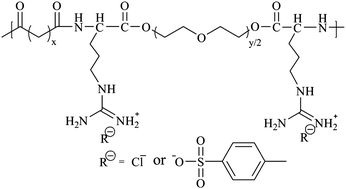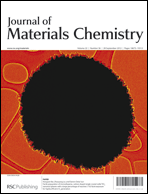Biodegradable arginine-based poly(ether ester amide)s as a non-viral DNA delivery vector and their structure–function study†
Abstract
The goal of this study is to develop a new family of L-arginine based poly(ether ester amide)s (Arg-PEEAs) as non-viral gene delivery vectors and study their structure–biological function relationships. A series of Arg-PEEAs were synthesized by the solution polycondensation reaction of the p-toluenesulfonic acid salt of L-arginine diester from oligoethylene glycol and di-p-nitrophenyl esters of dicarboxylic acids. The structure–function relationship was systematically studied through both the measurements of the fundamental property of the Arg-PEEA–DNA polyplex, like zeta potential and particle size, and various biological assays, such as gel retardation assay, GFP assay and luciferase assay. The introduction of the flexible oligoethylene glycol moiety into the Arg-PEEA backbone significantly increased the polymer chain flexibility, which helped to improve the transfection efficiency of Arg-PEEAs over rigid Arg-PEAs. The transfection results obtained from luciferase and GFP assays from a wide range of cell lines, primary cells and stem cells showed that some Arg-PEEAs had comparable or better transfection efficiency than the commercial transfection reagent Lipofectamine2000®, but at a much lower cytotoxicity.


 Please wait while we load your content...
Please wait while we load your content...